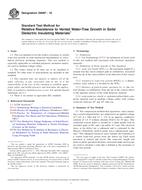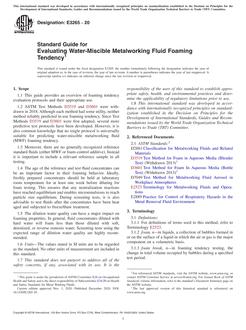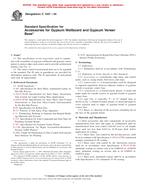1.1 This guide offers direction and guidance to the user concerning available techniques and methods for design, material selection, fabrication, erection, quality assurance, and control.
1.2 These minimum guidelines, when properly used and implemented, can help ensure a safe and reliable structure for the industry.
1.3 This guide offers minimum requirements for the proper design of a FRP liner once the service conditions relative to thermal, chemical, and erosive environments are defined. Due to the variability in liner height, diameter, and the environment, each liner must be designed and detailed individually.
1.4 Selection of the necessary resins and reinforcements, composition of the laminate, and proper testing methods are offered.
1.5 Once the material is selected and the liner designed, procedures for proper fabrication of the liner are developed.
1.6 Field erection, sequence of construction, proper field-joint preparation, and alignment are reviewed.
1.7 Quality-assurance and quality-control procedures are developed for the design, fabrication, and erection phases. The quality-assurance program defines the proper authority and responsibility, control of material and fabrication, inspection procedures, tolerances, and conformity to standards. The quality-control procedures provide the steps required to implement the quality-assurance program.
1.8 Appendix X1 includes research and development subjects to further support recommendations of this guide.
1.9 Disclaimer -The reader is cautioned that independent professional judgment must be exercised when data or recommendations set forth in this guide are applied. The publication of the material contained herein is not intended as a representation or warranty on the part of ASTM that this information is suitable for general or particular use, or freedom from infringement of any patent or patents. Anyone making use of this information assumes all liability arising from such use. The design of structures is within the scope of expertise of a licensed architect, structural engineer, or other licensed professional for the application of principles to a particular structure.
Note 1-There is no similar or equivalent ISO standard.
1.10 This standard does not purport to address all of the safety concerns, if any, associated with its use. It is the responsibility of the user of this standard to establish appropriate safety and health practices and determine the applicability of regulatory limitations prior to use.
Section Introduction and Background Scope and Objective 1 Referenced Documents 2 ASTM Standards 2.1 ACI Standard 2.2 NFPA Standard 2.3 ASME Standards 2.4 Terminology 3 ASTM Standard General Definitions 3.1 Applicable Definitions 3.2 Descriptions of Terms Specific to This Standard 3.3 Symbols 3.4 Significance and Use 4 Service and Operating Environments 5 Service Conditions 5.1 Environmental Severity 5.2 Chemical Environment 5.3 Erosion/Abrasion Environment 5.4 Operating Temperature Environment 5.5 Abnormal Environments 5.6 Other Operating and Service Environments 5.7 Static Electricity Build-Up 5.8 Flame Spread 5.9 Materials 6 Raw Materials 6.1 Laminate Composition 6.2 Laminate Properties 6.3 Design 7 Design 7.1 Assumptions 7.2 Dead Loads 7.3 Wind Loads 7.4 Earthquake Loads 7.5 Thermal Loads 7.6 Circumferential Pressure Loads 7.7 Load Factors 7.8 Resistance Factors 7.9 Loading Combinations 7.10 Allowable Longitudinal Stresses 7.11 Allowable Circumferential Stresses 7.12 Design Limits 7.13 Tolerances 7.14 Deflections 7.15 Critical Design Considerations and Details 7.16 Fabrication 8 Fabrication 8.1 Responsibility of Fabricator 8.2 Fabrication Facility 8.3 General Construction 8.4 Fabrication Equipment 8.5 Resin Systems 8.6 Reinforcement 8.7 Fabrication Procedures 8.8 Handling and Transportation 8.9 Erection Appurtenances 8.10 Tolerances 8.11 Erection of FRP Liners 9 Erection Scheme and Sequence 9.1 Handling and Storage on Site 9.2 Erection Appurtenances 9.3 Field Joints 9.4 Quality Assurance and Quality Control 10 Quality Assurance and Quality Control 10.1 Quality-Assurance Program 10.2 Quality-Assurance Surveillance 10.3 Inspections 10.4 Submittals 10.5 Operation Maintenance and Start-Up Procedures 11 Initial Start-Up 11.1 Operation and Maintenance 11.2 Annex A. Typical Inspection Checklist A1. Appendixes X. Commentary X1. Further Research and Development X2. Sample Design Calculations X3. FRP Chimney Liners in the Power-Generation Industry X4. Steady-State Temperature Distribution in Liner X5. References
Product Details
- Published:
- 01/01/1993
- Number of Pages:
- 29
- File Size:
- 1 file , 320 KB


